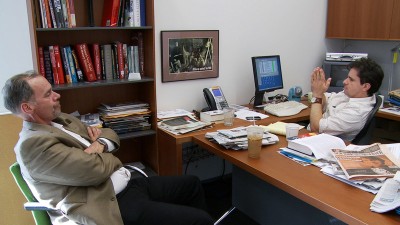| Reviews & Columns |
|
Reviews DVD TV on DVD Blu-ray 4K UHD International DVDs In Theaters Reviews by Studio Video Games Features Collector Series DVDs Easter Egg Database Interviews DVD Talk Radio Feature Articles Columns Anime Talk DVD Savant Horror DVDs The M.O.D. Squad Art House HD Talk Silent DVD
|
DVD Talk Forum |
|
|
| Resources |
|
DVD Price Search Customer Service #'s RCE Info Links |
|
Columns
|
|
|
Page One: Inside The New York Times

Please Note: The images used here are promotional stills and are not taken from the Blu-ray edition under review.
It is paradoxical that the way in which I'm transmitting (and you're receiving) my review of Page One: Inside The New York Times involves no ink or paper whatsoever, as this is just the kind of purely-digital information conveyance that gives Andrew Rossi's very spirited, entertaining, but also rather melancholy documentary its ominous central conflict and concern. The film is a privileged look at the inner workings of the hallowed and venerated New York Times, and as such, it gives us an encouraging glimpse of how high-standard journalism is generated and vetted so as to offer the public-service reliability and trustworthiness that the Times has traditionally prided itself and built its considerable reputation upon. But since all the hectic newsroom activity we see in the film is occurring even as cliff-diving print-ad revenues and a mass defection from newspapers to digital media has tolled what sounds like the death knell for daily morning papers all over the country, the question underlying the all stressful, noble work we're watching is, how long will it be able to continue, and is the fascinating newspaper documentary we think we're watching really a chronicle of institutional death with dignity, as some have claimed is inevitable?

Not that those hardworking, intrepid journalists are giving up without a fight. The film's "characters" are mostly those Times writers and editors assigned to the Media Desk, formed in 2008 to follow the very (r)evolution in technology and distribution that could leave the Times in its dust; for instance, the work that occupies the team most urgently at the moment they're being documented is the emergence of WikiLeaks as both source and rival. The star of this show is undeniably the irascible, no-bullshit David Carr, a Media Desk reporter who miraculously found himself invited to join the Times after decades of undermining his promising journalistic career with drug addiction and other reckless behavior. Carr's self-described "immigrant's love" for the Paradise that the paper seems to him manifests itself through his whip-smart, aggressive, tireless defense of it; Carr is like a bulldog, gruffly but affectionately keeping his more technology-happy Media Desk colleague Brian Stetler in check, and absolutely dismantling the glib arguments of the young digital-media upstarts with whom he goes head to head as he attends conferences and symposia on the fate of journalism in the 21st century. Carr's self-deprecating attitude only bulwarks his tenacious loyalty to what the Times means to stand for, and makes it all the more jarring when he bites someone's head off (as he does, in one compulsively rewatchable example, to a group of smart-alecky online journalists from Vice) if they impugn it.

Accompanying Carr at the film's center is the rest of the Media Desk team: Stetler, the good-hearted, wide-eyed former blogger whose position at the Times is as unexpected, if not more so, than Carr's, and who sometimes seems in over his head in the rigorous newsroom environment; Bruce Headlam, the buck-stopping editor of the Media section, whose rumpled, overinvested, I'm-getting-an-ulcer-here persona could not have been more suited to his role had he actually been cast; and, a bit further out in the inner circle, beat reporter Richard Perez-Pena and Tim Arango, a bright corporate-media reporter who never wanted to be anything but a great journalist and who gets promoted to Iraq correspondent for the Times halfway through the film. Higher-ups like executive editor Bill Kerr (who mediates the ongoing wrangling over which Times department/reporter gets the coveted "A-1" position in that day's paper) and foreign editor Susan Chira also chime in through their presence in meetings and in interview footage.
Around the periphery of that deadline-pressured newsroom tug-of-war, like the audience for a boxing match taking place in a prematurely condemned arena, are various media insiders and experts, whose interviews with Rossi are cut in where relevant: academics like Emily Bell of Columbia and Clay Shirky of NYU; former Times reporter and chronicler Gay Talese; famed Watergate journalist Carl Bernstein, Sarah Ellison of The Wall Street Journal, Nation editor/publisher Katrina vanden Heuvel, and The Atlantic's Michael Hirschorn (who wrote a controversial piece predicting the inevitable demise of the Times), among others, all of whom discuss the ongoing endangerment of primary-source, in-the-field reporting and the importance of a Times-like venue and infrastructure when it comes to making high-quality, ethical journalism a feasible ongoing occupation for the committed professionals who do actually venture out from behind their keyboards and Internet connections to dig out and deliver news from the real world--news that the much-hyped blogopshere is more often than not deeply reliant upon.

Rossi's DV-created style (he operated the camera himself, making him the film's one-man crew as well as its director) alternates between composed, elegantly framed and lit shots and pans that put the Grey Lady's sleek modern offices on display and jerky, blurry handheld work that conveys the nonstop, combative hamster wheel of a day's toil preparing an edition that conforms in every respect to the highest possible standards. Rossi's editing team (Chad Beck, Christopher Branca, and Sarah Devorkin) uses that alternation and other juxtaposition techniques involving the ongoing commentary and discussion about the future of the Times and its ethos to create a mounting point-counterpoint rhythm, turning the film into a sometimes quite heated conversation about the presumed venerability of the Times (which, as Rossi does carefully point out through conscientious inclusion of archival footage, has not gone untainted, as in the scandalous cases of Jayson Blair, who fabricated and falsified sources, and, worse, Judith Miller, who served as submissive mouthpiece for the Bush Administration, dutifully spreading their lies about WMDs in the lead-up to the Iraq invasion) and what will happen to its ideals if print news media goes away.
Ultimately, it is the commitment to finding and delivering the facts, and only the verifiable facts, that represents the New York Times at its best--a commitment exemplified by the tense, worried, sometimes garrulous, but completely devoted group of journalists we meet in Page One--that Rossi and his subjects are concerned about, faced as it is with diminishing revenues and painful staff cuts, as well as the widespread failure and disappearance of daily newspapers. But it is the strength of that commitment that offers the film's ray of hope; where the resources will come from to make a dedication to responsible, responsive journalism vocationally viable is frighteningly uncertain and remains to be seen, but as long as people like David Carr, Bruce Headlam, and Bill Stetler are the ones looking for a way to overlap in-depth journalism, all its traditional virtues intact, with the transition from the printed page to the computer screen, there is good reason to have faith that, although the "how"--the media and formats through which we consume our daily news--may be mutable and disconcertingly unstable, the "what"--the high-quality content created by ethical and skilled professional journalists--can abide into the future.
THE BD:
The AVC/MPEG-4, 1080p, 1.78:1 aspect-ratio anamorphic widescreen transfer is able to do full justice to the film's sometimes (appropriately) raw, blurred handheld-DV aesthetic. There are certainly no flaws in the transfer itself; any glitches are part of the source material and its aesthetic, and all surfaces, colors, and skin tones are as stable and sharp, in all kinds of light, as they're meant to be.
Sound:Again, it is in keeping with the candid, spontaneous documentary style of Page One that the sound from Rossi's one-man shoot has varying degrees of quality and is sometimes muffled, tinny, or with slight distortion. The disc's DTS 5.1 Master Audio soundtrack itself, however, is entirely up to par, as indicated by the clarity and fullness of post-production sound (mainly score) and overall fidelity to all original sound sources, which leaves everything clearly audible despite the variations in the quality of those sources.
Extras:--Twenty minutes of additional scenes that would not have belonged in the film but do offer some looser, entertaining individual peeks at Headlam, Stetler, and, especially, David Carr, whom we see briefly participating in the Times's video blog from a makeshift film studio in his basement, complete with loud furnace interruptions.
--Individual segments, each under five minutes, that are extended versions of the interviews with Carl Bernstein, Emily Bell, and Sarah Ellison excerpted throughout the feature.
--"Journalists React to Page One," in which notables like NBC's Brian Williams, CBS's Bob Simon, and Enron: The Smartest Guys in the Room producer Jason Kliot offer their brief, on-the-fly impressions and thoughts on their way out of a screening.
--"Q&A Highlights with the Cast and Filmmakers," 15 minutes of snippets from various interactions between Carr, Stetler, Headlam, and Rossi at different festivals, events, and screenings across the country.
--"Tim Arango with Joao Silva in Iraq,": An extension of Arango's story after he is promoted away from the story Page One tells to work for the Times in U.S.-occupied Iraq, and a moving, too-brief document of his friendship with war photographer Silva, who eventually lost both legs in an explosion while on assignment in Afghanistan. This story is compelling enough to have warranted a documentary of its own.
--Finally, a handful of trailers for other Magnolia Pictures releases.
FINAL THOUGHTS:An inside look at a beleaguered American institution as it tries to survive a rollercoaster of an evolving business model, Page One: Inside The New York Times is certainly required viewing for anyone concerned about the maintenance of journalistic standards in the hyper-speed information marketplace. But more than that, director Andrew Rossi has pulled off his own feat of in-depth, well-organized reporting to the extent that, even if you had only a casual or nonexistent interest in the fate of the daily newspaper before seeing his film, you may find that the entertaining, diverting, enlightening, and ultimately galvanizing experience of watching it has actually had the power to convince you that it is an issue worth keeping on your radar. Highly Recommended.
|
| Popular Reviews |
| Sponsored Links |
|
|
| Sponsored Links |
|
|
| Release List | Reviews | Shop | Newsletter | Forum | DVD Giveaways | Blu-Ray | Advertise |
|
Copyright 2024 DVDTalk.com All Rights Reserved. Legal Info, Privacy Policy, Terms of Use,
Manage Preferences,
Your Privacy Choices | |||||||












